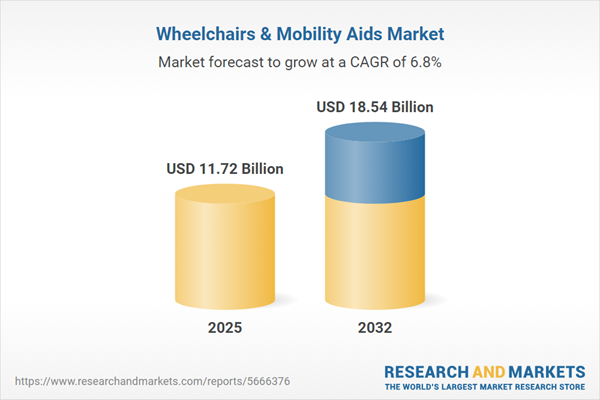Speak directly to the analyst to clarify any post sales queries you may have.
The wheelchairs and mobility aids market is undergoing significant transformation, driven by technological innovation and evolving regulations. Senior decision-makers must access timely, clear intelligence to position their organizations for long-term success and operational responsiveness in this dynamic environment.
Market Snapshot: Wheelchairs and Mobility Aids Market
The global wheelchairs and mobility aids market is experiencing steady compounded annual growth as demographic shifts increase demand for specialized mobility solutions. The market is shaped by an expanding aging population and a heightened focus on both user experience and clinical outcomes. Manufacturers, healthcare providers, and distributors are accelerating product innovation to cater to an increasingly diverse user base. Adaptability and compliance remain central, with ongoing regulatory changes influencing procurement practices and driving organizations to refine offerings aligning with both clinical standards and user expectations. Industry players are also increasingly prioritizing operational agility and technological integration to maintain resilience in fluctuating procurement and compliance environments worldwide.
Scope & Segmentation: Wheelchairs and Mobility Aids Market
This detailed market research report is designed to empower executives and investors with the insight needed for actionable decision-making and sustainable strategy development. The competitive landscape and strategic priorities within key industry segments are explored based on prominence and emerging trends:
- Product Types: Manual wheelchairs, powered wheelchairs, mobility scooters, stairlifts, canes, rollators, and walkers remain at the core of market segmentation. Innovative modular designs and customizable features are increasingly being prioritized to accommodate a broad range of user and clinical needs.
- End Users: Homecare recipients, hospitals, rehabilitation centers, long-term care facilities, and rental providers are key stakeholder groups. Each segment requires nuanced procurement strategies with a shared emphasis on user safety, autonomy, and ongoing support for independent living.
- Distribution Channels: Products are delivered through hospitals, clinics, medical suppliers, pharmacies, specialist retailers, and rapidly growing digital platforms. Online and e-procurement channels are advancing supply chain efficiency and enhancing accessibility to mobility aids for diverse regions and facility types.
- Regional Coverage: Geographic analysis includes the Americas, Europe, Middle East, Africa, and Asia-Pacific. The report presents tailored insights into local market behaviors, procurement practices, healthcare frameworks, and regulatory landscapes across the United States, Canada, China, the United Kingdom, India, and Germany.
- Company Profiles: Market leadership and innovation are illustrated through profiles of major contributors: Invacare, Sunrise Medical, Permobil, Pride Mobility, Drive DeVilbiss, GF Health, Otto Bock, Handicare Group, Medline Industries, and Karma Medical Products. Strategic focus areas include their product development pipelines, market positioning, and customer engagement initiatives.
Key Takeaways for Senior Decision-Makers
- Manufacturers and care providers are advancing product enhancements by adopting feedback from clinicians and end users, ultimately supporting improved safety and long-term independence across care environments.
- Integration of cutting-edge technology—including advances in artificial intelligence and remote monitoring—is resulting in smarter, more connected mobility aids that benefit both users and care teams through operational gains.
- Personalized mobility solutions are being developed to more effectively match individual needs, expanding accessibility and supporting efficient allocation of resources within clinical and homecare settings.
- Procurement models are swiftly adjusting as organizations seek flexible, predictive supply chain strategies in response to changes in both operational demands and regulatory expectations.
- The convergence of digital, hybrid, and direct procurement channels aligns with evolving purchasing behaviors, bolstered by improvements in procurement technology and platform integration.
- Industry-wide collaboration among manufacturers, technology partners, and distributors is crucial to establishing interoperability standards and addressing emerging market requirements with greater speed and precision.
Tariff Impact and Supply Chain Considerations
Recent tariff adjustments in the United States have influenced sourcing and logistics decisions, compelling multinational organizations within the mobility aids sector to adapt with domestic assembly and more agile supply chain structures. While large enterprises invest in flexible frameworks to minimize risk exposure, smaller firms are leveraging strategic partnerships and process streamlining for cost-effectiveness. Achieving resilience now relies on procurement processes that are both innovative and adaptable to regional market changes.
Methodology & Data Sources
The findings in this market report are based on structured interviews with industry executives and procurement specialists, reinforced by analysis of government regulations, peer-reviewed articles, intellectual property data, and advanced modeling. These methodologies support the delivery of actionable, reliable insights for executive-level planning.
Why This Wheelchairs and Mobility Aids Market Report Matters
- Enables senior decision-makers to anticipate shifting technology and regulatory priorities, underpinning agile and resilient corporate strategies.
- Supports benchmarking and go-to-market initiatives through current analytics aligned with sector developments and evolving market standards.
- Enhances sourcing and procurement readiness by highlighting innovative supply chain solutions and facilitating seamless adoption of emerging procurement platforms.
Conclusion
Organizations that leverage actionable market analysis and responsive planning are better positioned to navigate the evolving landscape of wheelchairs and mobility aids, ensuring both operational resilience and a robust competitive edge.
Additional Product Information:
- Purchase of this report includes 1 year online access with quarterly updates.
- This report can be updated on request. Please contact our Customer Experience team using the Ask a Question widget on our website.
Table of Contents
3. Executive Summary
4. Market Overview
7. Cumulative Impact of Artificial Intelligence 2025
Companies Mentioned
The companies profiled in this Wheelchairs & Mobility Aids market report include:- Invacare Corporation
- Sunrise Medical Group NV
- Permobil AB
- Pride Mobility Products Corporation
- Drive DeVilbiss Healthcare, Inc.
- GF Health Products, Inc.
- Otto Bock SE & Co. KGaA
- Handicare Group AB
- Medline Industries, L.P.
- Karma Medical Products Co., Ltd.
Table Information
| Report Attribute | Details |
|---|---|
| No. of Pages | 194 |
| Published | October 2025 |
| Forecast Period | 2025 - 2032 |
| Estimated Market Value ( USD | $ 11.72 Billion |
| Forecasted Market Value ( USD | $ 18.54 Billion |
| Compound Annual Growth Rate | 6.7% |
| Regions Covered | Global |
| No. of Companies Mentioned | 11 |









